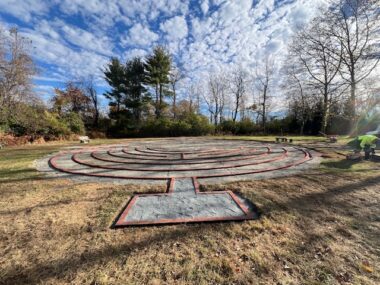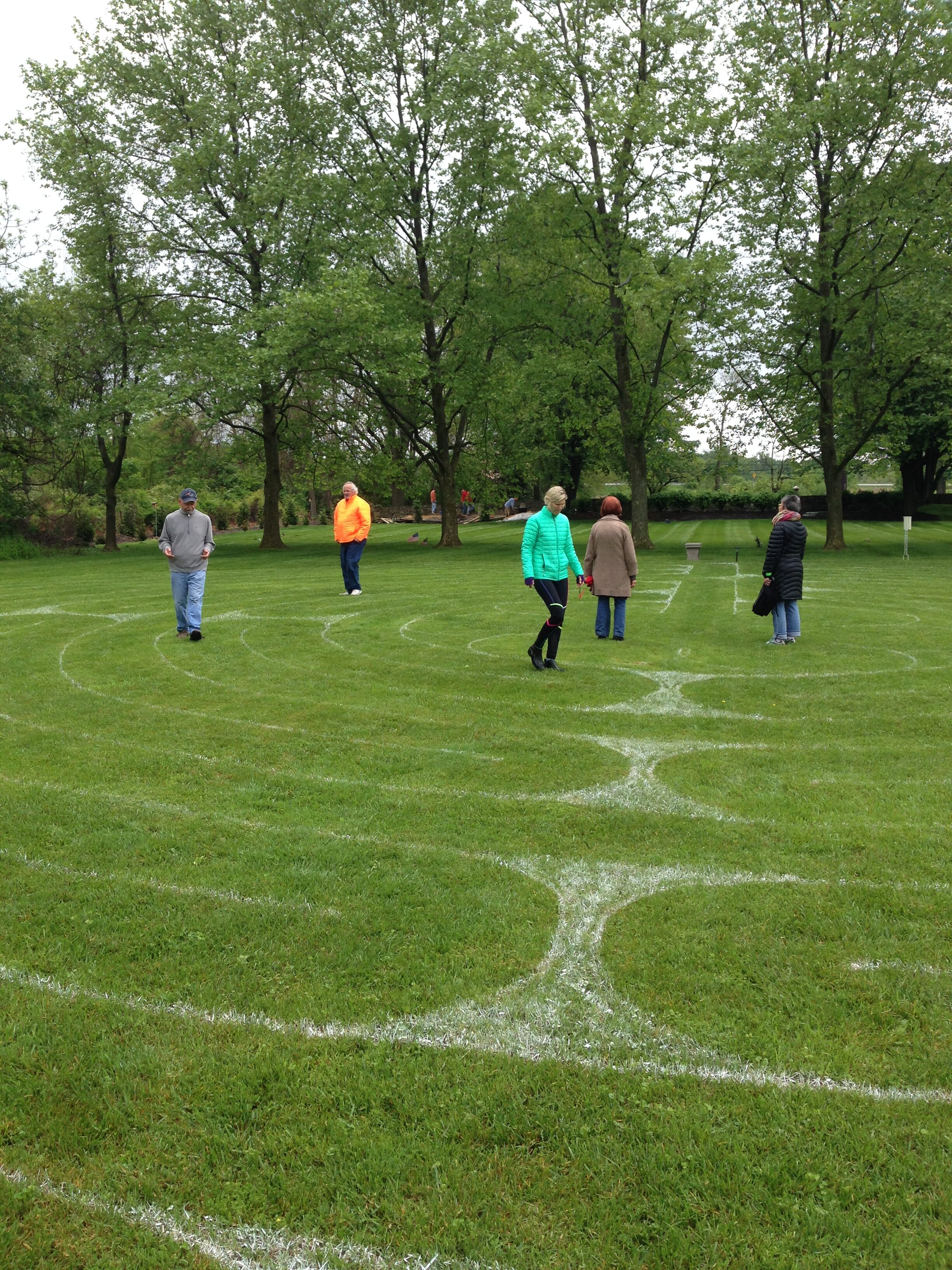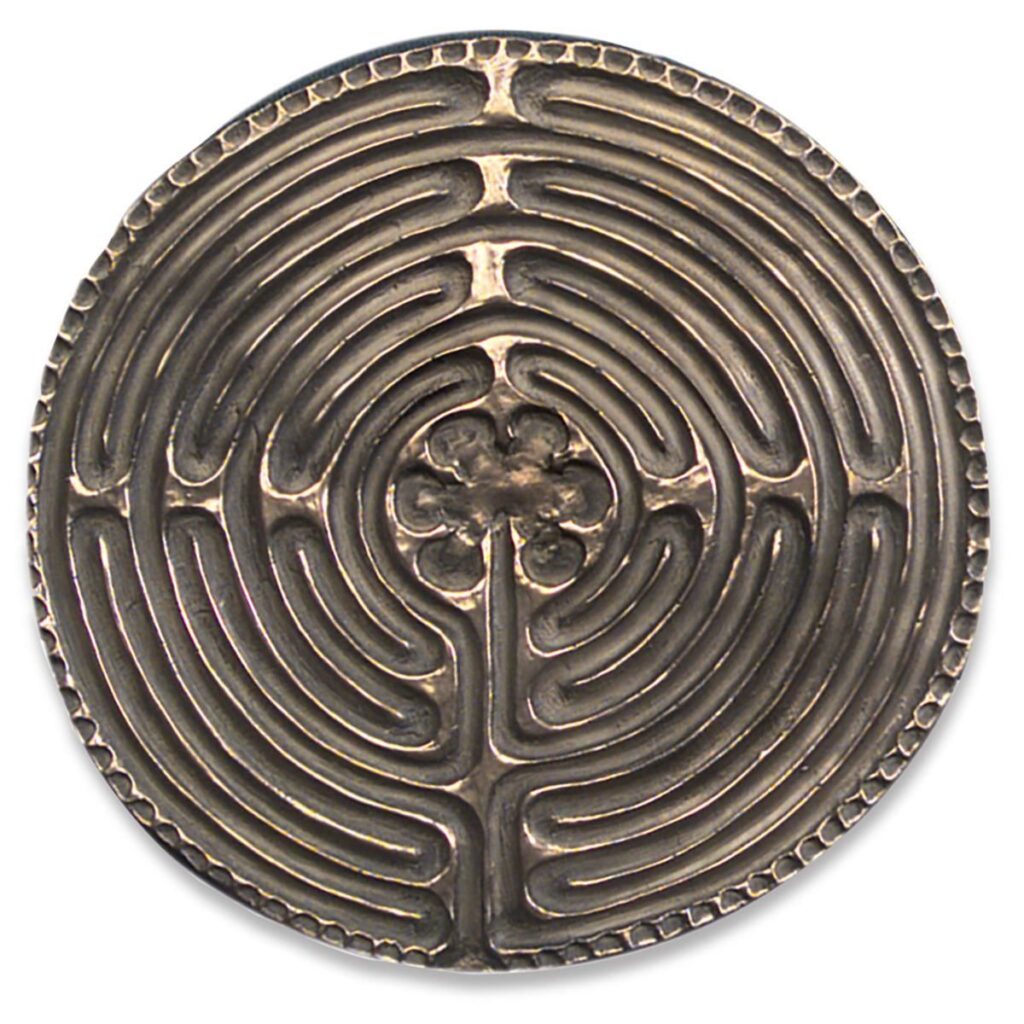“Not all those who wander are lost” ~ J.R.R. Tolkien
St. Paul’s Labyrinth
A labyrinth is a circuitous and sometimes complex path that one walks from an entrance to the center, then back again. The path of a labyrinth is like the path of life – with twists and turns, feelings of being lost, encounters with others in your path, a thrill of pleasure as you approach the center and sometimes a flash of insight before you leave. Labyrinths are used world-wide as locations to quiet the mind, calm anxieties, recover balance in life, enhance creativity, and encourage meditation, insight, self-reflection and stress reduction. Walking a labyrinth allows integration of body, mind and spirit, giving time to meditate on one’s journey with God.


The St. Paul’s Labyrinth, refreshed and dedicated in November 2025, is a permanent, accessible, and easily maintained prayer and meditation space on our beautiful Chester County campus. Utilizing one of the most revered designs originally created in 1200 AD for the priests of Our Lady de Chartres in France, the St. Paul’s Labyrinth features wider walkways of red and gray paver stones, designated meditation spots with cedar benches, and permanent landscaping that will be installed when the weather warms in Spring 2026. The St. Paul’s Labyrinth is now available all day, every day, year-round, weather permitting.
The Inward Journey (Releasing)
As you walk the winding path toward the center, the repetition of steps helps to clear the mind and let go of daily worries, distractions, and personal burdens. This stage is for self-reflection and confession.
-
- Prayer Focus: Surrender, letting go of worries, asking for forgiveness, releasing control, bringing a specific issue to God, quieting the inner critic.
- Example Prayer Ideas:
- “Lord, I surrender my worries and fears to You.”
- “Help me to let go of [specific worry or sin].”
- Repeating a short phrase like “Thy will be done” or “Lord, have mercy”
The Center (Receiving)
The center (the six-petaled “rose” design) is the goal, symbolizing union with God, the “still point,” or the Celestial City of Jerusalem. This is a place for rest, listening, and receiving guidance or healing.
-
- Prayer Focus: Centering in God’s presence, receiving clarity, listening for inner wisdom, experiencing healing, expressing gratitude, discerning one’s next steps.
- Example Prayer Ideas:
- “I rest in Your presence, God.”
- “What is my next step, Lord?”
- “Thank You for Your abundant blessings and grace.”
- (Optional: Use the six petals to pray for six important people or concerns in your life).
The Outward Journey (Returning)
The path back out of the labyrinth represents returning to the world with a renewed spirit and a sense of purpose. This stage is for intercession and integration.
-
- Prayer Focus: Interceding for others, reflecting on how to apply insights to daily life, giving thanks for the journey, taking action on God’s guidance.
- Example Prayer Ideas:
- “I pray for the needs of others, especially [person’s name].”
- “Help me to live out Your will in the world.”
- “May I carry the peace I found here back into my life.”
General Guidance
- Be Open: Walk with an open mind and heart, ready to receive whatever comes.
- Walk at Your Own Pace: There is no need to rush; move slowly and mindfully.
- Use Scripture: Meditate on a favorite scripture passage as you walk.
- Embody Prayer: Sometimes, no words are necessary; simply moving through the space in a prayerful attitude is enough.
Labyrinth practice quiets the body and mind so that you can listen more easily and relate more deeply with yourself and God. Before you begin, decide why you are going to walk. Focus.
You enter the labyrinth and follow the path as it winds its way toward the center. You pause in the center as you like, then turn and exit the labyrinth on the same path you came in, just going the opposite direction. A labyrinth is used for walking meditation. It is a single winding path from the outer edge in a circuitous way to the center. Labyrinths are used world-wide as a way to quiet the mind, calm anxieties, recover balance in life, enhance creativity and encourage meditation, insight, self-reflection and stress reduction.
“Do not worry about anything, but in everything by prayer and supplication with thanksgiving let your requests be made known to God. And the peace of God, which surpasses all understanding, will guard your hearts and your minds in Christ Jesus.” Philippians 4:6-7
Suggested steps for a labyrinth walk:
- Stand before the entrance and pray, dedicating the walk.
- Move into the pattern. The path you are on leads to the center. Trust. Go at any pace (fast or slow) that seems comfortable. Notice what is happening around you and make it part of your walk. If you get turned around, you will either end up in the center or at the entrance/exit. Wherever you find yourself, continue from there. You can always leave the labyrinth if you want to.
- When you get to the center, rest. Reflect on what has happened so far or simply tune in to what you are sensing. Don’t hurry away.
- When you are ready, take the pathway back out. You may wish to continue with what has started or consider how to integrate what you have uncovered into your life.
- When you reach the threshold, give thanks for whatever your experience has been.
- After moving off the pattern, reflect on what happened. You may even wish to write down your thoughts and feelings, or creatively express them in another way (e.g., drawing, movement).
Ref: https://praywithjillatchartres.com/labyrinth-2/labyrinth-walking-at-chartres/praying-on-a-labyrinth-seven-suggested-steps/ Accessed 11.5.2025

Walking the Labyrinth is a personal spiritual journey that encourages each person to pray or meditate in whatever ways are most comfortable for them. The prayers provided here are merely suggestions for those seeking a starting point of reflection.
Labyrinth Prayer Starters
There are at least as many ways to pray when using a labyrinth as there are people who pray it. The following suggestions pair a spiritual activity with praying while using the St. Paul’s Labyrinth.
Caring
“God, [person’s name] is in need…”
Centering
When you feel or perceive God’s presence, move into it more deeply.
Chanting
Singing “Alleluia”, your favorite hymn or song, or a chant that makes sense for you.
Discerning
Talk with God about something important.
Focusing
Repeat a favorite name for God, (e.g., “Jesus, Jesus…” or, “Healer, healer…”); a spiritual word that has significance for you (e.g., “Love…”), or a short prayer (e.g., “Please help!” or “Thy will be done”)
Grieving
“Please help me to stay present to this pain. Support me as I move with it.”
Imaging
Holding someone or something in an internal visual state that represents your deepest desire.
Interceding
Plead with God on behalf of others.
Moving
Embody your sacred communication. No words are necessary.
Opening
“I’m here. Help me to stay open to You.”
Praising
Speak God’s name or attributes with love and appreciation.
Questioning
“What is my next step?” “What do I need?”
Reading and Reflecting
Read or recall a biblical story. Ponder its meanings as you move. Take your scriptures with you. Stop anywhere to read and respond.
Releasing
“Help me let go of….” or “I forgive…”
Searching
“God, I need to understand…”
Seeking
“God, show Yourself to me.”
Singing
Choose a favorite spiritual song or hymn. Sing it silently or out loud.
Transitioning
“Ever since [person’s name] died….”
“Thank You, God, for the new opportunity….”
Reference: https://praywithjillatchartres.com/labyrinth-2/suggested-approaches-for-prayerful-labyrinth-encounters/ Accessed: 11.5.2025
Prayer of Surrender
“Lord, as I walk this labyrinth, I surrender my worries, fears, and anxieties to You. Help me to release control and trust in Your divine guidance. Lead me along the path of peace and fill me with Your presence. Amen.”
You can also meditate on this verse:
“Cast your cares on the Lord and he will sustain you; he will never let the righteous be shaken.” Psalm 55:22
Prayer for Guidance
“God of wisdom, as I journey through this labyrinth, grant me clarity and insight. Illuminate my path and guide my steps. Open my heart to receive Your guidance and discern Your will for my life. May I walk with purpose and intention, following the path You have laid before me. Amen.”
You can also meditate on this verse:
“For I know the plans I have for you,” declares the Lord, “plans to prosper you and not to harm you, plans to give you hope and a future.” Jeremiah 29:11
Prayer for Healing
“Healer of body and soul, as I walk this labyrinth, I bring before You my pain, grief, and brokenness. Pour out Your healing grace upon me and those I hold in my heart. Grant strength to the weary, comfort to the afflicted, and hope to the discouraged. May Your love surround us and bring wholeness to our lives. Amen.”
You can also meditate on this verse:
“He heals the brokenhearted and binds up their wounds.” Psalm 147:3
Prayer of Gratitude
“Gracious God, as I journey through this labyrinth, I am filled with gratitude for Your abundant blessings. Thank You for the gift of life, for the beauty of creation, and for the love that surrounds me. Help me to cultivate a spirit of gratitude in all circumstances and to live each moment with a thankful heart. Amen.”
You can also meditate on this verse:
“Rejoice in the Lord always. I will say it again: Rejoice!” Philippians 4:4
Prayer for Renewal
“Renewing Spirit, as I walk this labyrinth, breathe new life into my weary soul. Revive my spirit with Your presence and refresh me with Your grace. Grant me the strength to let go of the past and embrace the possibilities of the future. May this journey be a catalyst for transformation, as I emerge renewed and restored in Your love. Amen.”
You may also wish to meditate on this verse:
“Do not conform to the pattern of this world but be transformed by the renewing of your mind. Then you will be able to test and approve what God’s will is-his good, pleasing, and perfect will.” Romans 12:2
Feel free to personalize these prayers or adapt them to suit your own spiritual beliefs and intentions as you walk the prayer labyrinth.
Summary Prayer Labyrinth
As we navigate the complexities of life, the prayer labyrinth stands as a timeless reminder of the transformative power of faith, hope, and love. Whether in times of joy or sorrow, abundance or scarcity, the labyrinth encourages us to walk with resolve, resilience, and grace, trusting in the divine guidance that leads us toward healing, growth, and renewal.
May we continue to embrace the journey of the labyrinth with open hearts and minds, allowing its sacred rhythms to nourish our souls and uplift our spirits on the path to mental health, wholeness and connection with God.
“…he refreshes my soul. He guides me along the right paths for his name’s sake. Even though I walk through the darkest valley, I will fear no evil for your rod and your staff they comfort me.” Psalm 23: 3-4 (NIV)
Reference: https://peacefamilycounseling.com/prayer-labyrinth-a-way-to-reflect-and-connect-with-god-part-2 Accessed: 11.5.2025
The labyrinth is perhaps one of the oldest, and certainly one of the most mysterious symbols known to mankind. It has been looked upon as an object of fear and hope. It has been perceived as a representation of hell and redemption, and it has even been used to symbolize far off lands and cities. Labyrinths and Mazes have a history that can be traced back some 4000 years.
St. Paul’s Labyrinth follows the Chartres Cathedral design, a centuries-old pattern of spiritual journey and renewal. The original labyrinth was set into the stone floor of Chartres Cathedral in France around 1200 A.D. During the Middle Ages, walking the labyrinth served as a form of pilgrimage for those unable to travel to the Holy Land. Its eleven circuits, divided into four quadrants, symbolize the soul’s pilgrimage toward God.
The Chartres design is rich in sacred symbolism:
- The six-petalled rose at the center represents love, the union of the soul with God, and the presence of the Holy Spirit.
- The cross-shaped form spanning the entire pattern reminds us of Christ’s redeeming love.
- The circle symbolizes eternity, wholeness, and the divine nature of Gad, without beginning or end.
- The center of the circle is geometrically the point of perfect balance, also called the “still point”.
- The 4 quadrants reflect the seasons and the directional points of north, east, south and west.
- An invisible thirteen-point star unites the design, representing Christ and the twelve apostles.
The earliest examples of labyrinths found carved on rocks all have the same design – unicursal paths designed to lead the user without offering choices to the goal. This design was taken by the Romans and new forms were created for use on mosaic floors. Further developed during medieval times, the labyrinth design then appeared on the floors of churches and cathedrals in Europe, on village greens and hilltops, on remote coastlines and islands in Scandinavia, up to the Arctic Circle and beyond.
The labyrinth symbol also may be found throughout India, as far away as Sumatra and Java and in the American Southwest, although many questions remain as to when it first appeared and how it spread to many of these regions. During the late medieval period, the labyrinth design was adapted further into the familiar puzzle mazes of tangled hedges in parks and gardens that we know today. Labyrinths became popular again in the 19th century, but it was not until the late 20th century that labyrinths and mazes found new acceptance. Now in the 21st century, they are more popular than at any time throughout their history.

Design of the Chartres Labyrinth
